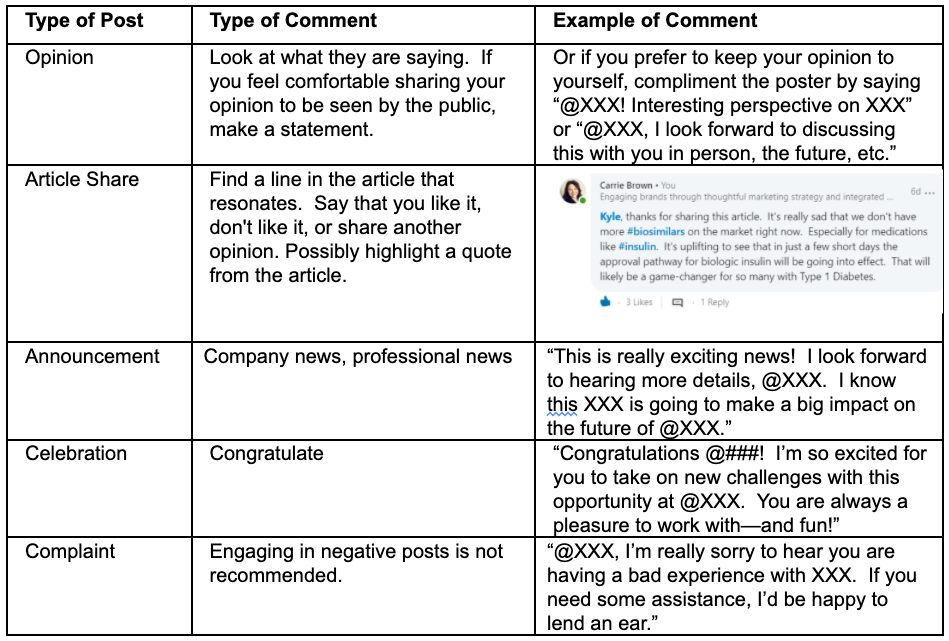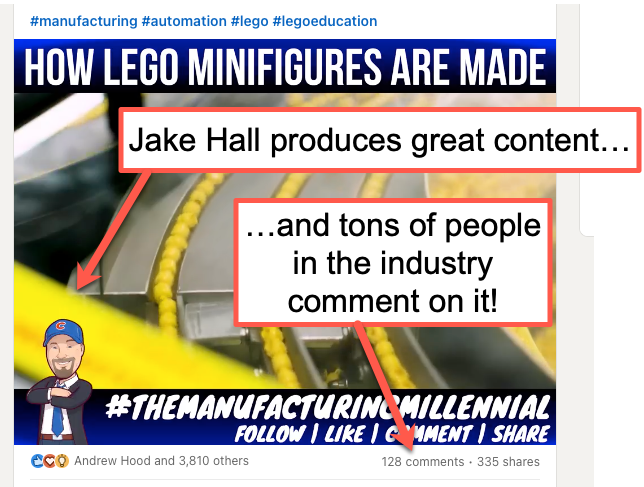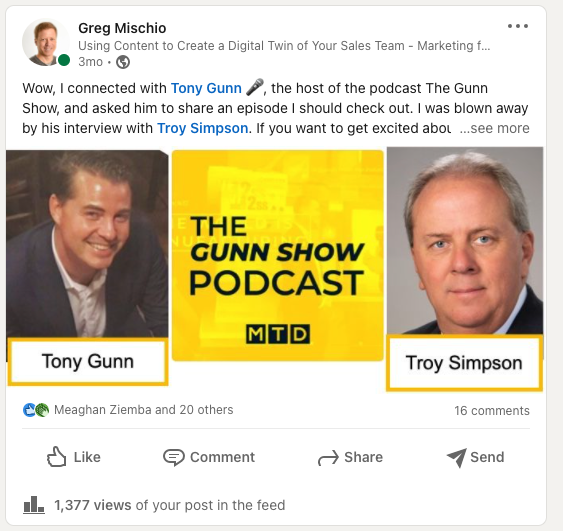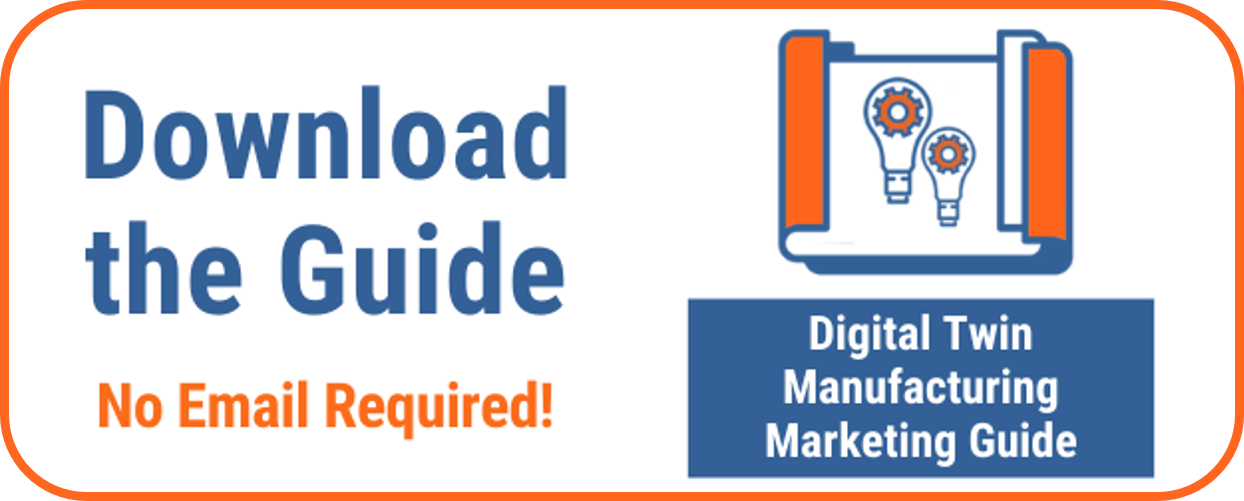Why, oh why can’t you get your manufacturing sales team to engage on LinkedIn?
For sales and marketing leaders, this is a head-scratcher, especially when you consider the research. According to LinkedIn, salespeople who engage in social selling are significantly better than their peers:
- 78% of social sellers outsell peers who don’t use social media.
- Social selling leaders are 51% more likely to reach quota.
Yet despite these stats, many salespeople resist the potential of using LinkedIn.
Marketing pros — eager to boost sales and add another avenue to help deliver marketing messaging — will roll out training programs to the sales team, but often to no avail.
Though it may seem impossible, with a lot of empathy and by using the following four steps championed by other marketers, you can get salespeople to engage:
1. Understand the main reason why they’re not engaging
2. Create a sales-friendly training program that’s relevant to sales
3. Promote “content-light” LinkedIn tactics
4. Support their efforts by lending a marketing hand
Let’s dig in!
Step 1: Understand the main reason why they’re not engaging
Before we can cure what ails us, we need to understand what’s causing the ailment. And I believe it ultimately boils down to one thing:
Salespeople aren’t content producers.
When we’ve rolled out LinkedIn training to salespeople in the past, we can share success stats like the ones above, and everyone agrees it’s a great idea.
But when we get to either creating content, or even sharing other people’s content, they squirm.
Why? Because the majority of salespeople typically don’t like to produce content. They are not alone. Research shows that only 1% of users add content to an online community.

Source: Wikipedia
Anecdotally, my experience with salespeople backs that up. I think it’s because of how we communicate.
Salespeople’s communication is spontaneous and interpersonal. It’s generated when they are face-to-face with the audience. They are great off-the-cuff; they can dance on their feet; and they can do the give-and-take. They are very much in the moment.
Marketing’s communication is structured, calculated and speaks to the masses. Our creativity is born of ideas, imagery and graphics. Our storytelling is one-to-many. We are more comfortable publishing our thoughts for all to see.
This disconnect is the biggest stumbling block. Yes, there are issues of time and the fact that LinkedIn is a long-term approach. Sure. But the most successful salespeople make time for winning strategies, and they understand long-term sales.
So what do we do?
Step 2: Create a sales-friendly training program that’s based on goals
Salespeople are goal-oriented, not strategy-oriented. Any strategic initiative marketing rolls out needs to be tied to goals — particularly ones that show the sales team how they benefit.
You can roll out the broad-based marketing strategy (our Digital Twin Marketing Strategy is based on getting people to know you, like you and trust you), but then move on to setting the goals to meet the strategy. These can include:
1. Activity (choose from the tactics below)
2. Connections / Meetings (track how many connections you make and meetings you set with Prospects AND Referrals)
3. Sales (how many closed deals will result)
Then share the approach, explaining how the design of your program appeals to their strengths.
Establishing this mindset and building a program around them is critical.
A lot of the initial work I do with clients’ sales teams is to help them understand how LinkedIn/digital fits into their existing sales process and actually makes it easier. That mindset has to come before the skill sets and toolsets.
Train them in short chunks
Once you’ve laid out your approach, training is critical. For the love of all that is holy, do not pack them in a room and go through an hour-long PPT on your program.
I have done this, and if I hadn’t been on Zoom, I swear someone would have thrown a chair at me.
Salespeople seem to suffer an abnormally high rate of ADHD, so keep your training short and in hands-on chunks.
We essentially need to help them build muscles they don’t use yet. This means we need to serve as their coach and mentor, and break the process down into very measured and achievable steps for them.
We’ve had great success with a hands-on workshop approach, in which we bring up someone’s profile and then walk through the process of connecting, tagging and leaving comments.
A 20-30 minute hands-on screen share coaching session every week for a few months will build the muscles, and a small win or two will help make it a habit.
Step 3: Use engagement tactics that play to their strengths
Once you have some goals established and your hands-on training set up, now you can use some of these sales-friendly LinkedIn tactics.
Leave comments
Let’s start with the concept of just leaving comments overall.
Piggyback on someone else’s content and share your reactions in short bursts. You don’t have to be a Shakespeare — you just have to have an opinion. Just leaving comments can help open doors and build referral sources.
Just read other people’s content, then leave your reactions. You can also quote them in your own posts.
It is important just to start! Grab info from blogs, have conversations on posts. Hunt the relationship as John Buglino would say.
It’s really about the comfort zone for salespeople. And jumping into a conversation comes naturally to salespeople.
All good salespeople understand customers and can add relevant comments to a conversation, whether offline or online. It’s about comfort and habit. It’s not much of a comfort zone stretch to send a LinkedIn message to someone that replies to your comment.
Carrie Brown shared this exceptional matrix of the different types of comments you can leave.

Making comments is the best and easiest way to open doors.
Leave comments on your company LinkedIn posts
A great place salespeople can comment and add extra insight is on your own company posts. You know the subject matter, and you can help the company get the word out.
I like and comment on every company post to help get the word out about my organization. We are all in it together. Every little bit helps us grow and that is the job of sales, not just marketing.
This is a bit different than sharing a company post. Shares tend to get ignored on LinkedIn. But comments will be far more likely to trip the LinkedIn algorithm and get you exposure.
You can take it a step further, and use this tip from Taryn Stoeger that builds on what Dan does.
Another great way non-marketers can contribute is by inviting their connections to your company page. This takes the pressure off sharing every post for the company and helps keep the momentum going for them.
Leave comments on polls
John Buglino provides us with another tactic.
Engage with some polls, not all, (you will have no more time in your day) on #LinkedIn. But simply checking your answer is not enough.
Here’s John’s approach:
– Select your answer
— State your answer in the comment + tag the author
— ‘React’ to other comments/engagement
—- Connect with everyone that reacted to that poll
Go back to the post once the poll closes (!!!!!!!!!!) – LI sends you a notification when the poll closes and says ‘check out the results.’
For once…. do as the platform suggests!
– Go to the poll
— Look at the results
— Leave another comment or two
—- Connect with others that engaged after you left
Connect with other commenters
You don’t have to work so hard to find your target market. Look for the multitudes that are commenting on big time content producers like Jake Hall, Will Healy III, Curt Anderson and more.
Then connect with those folks, referencing the post you both reacted to. “Hey, saw you left a comment on…”
Just look at the number of comments on Jake Hall’s post alone! Many of these folks are in the manufacturing industry.

After you connect, meet on zoom
Why everyone thinks a relationship is formed from a like or a comment is beyond me. Take the next step. Once you’re connected, ask if the person would like to meet one-on-one. At the very least, you’ll make a new friend and expand your horizons.
It never hurts to learn more about how others integrate into the industry.
Will Healy notes that he followed the lead of salespeople who weren’t content creators per se, but they were leveraging their interpersonal skills to connect and build relationships.
I first started on LinkedIn because of some savvy salespeople on our team that realized really early on that this was a resource and of value for them. The best are out there connecting and direct messaging with people doing the networking that they do best. They are regularly turning virtual introductions into real relationships.
Pay it forward and reward other content producers
I love sharing the podcasts and video programs of Chris Luecke, Joe Sullivan, Sam Gupta, Ray Ziganto, Damon Pistulka √, Joseph Lewin, Allison DeFord, Meaghan Ziemba and others.
Not only do they consistently get great clients and open my eyes and brain to new insights and thinking, they are also great networking opportunities. Plus, these folks just work their arses off, and I think they deserve a round of applause for boosting the industry. Here I give a shout-out to Tony Gunn.

You can also fold this into your commenting strategy.
Once connected to a producer or follower, ask them for a recommendation for a page/person/podcast to follow. Asking a favor, I have found, is the greatest way to spark a relationship.
Step 4: Support their efforts by lending a marketing hand
Sometimes the sales team doesn’t know where to start. So give them plenty of ideas where they can go to leave those comments. Meaghan Ziemba shares some great ideas she’s used in the past:
- Set up weekly email sends with the content we’ve posted including the links to all the channels, plus any hashtags for the posts.
- Talk to sales teams about who is commenting on the content by sending them screenshots so they can respond at their convenience.
- Communicate any negative or positive reviews left on posts so the team can address them directly, either on the post or via email/phone call.
The old school of thinking involved marketing and sales being separate entities from one another, but more and more companies are bringing the groups together and I am seeing more collaboration.
Create content based on what they need
The ultimate spark will be provided if you get a sense of what’s really important to the sales team, and what kind of content they want marketers to create.
Set up a regular meeting to exchange ideas between the sales and marketing team. Instead of assuming you know what content they need, ask them.
Track the program and report on goals
Any program like this requires a win-win approach, and total buy-in from both sales and marketing. Refer back to the numbers you established out of the gates to report on the sales goals.
Remember, salespeople are number-driven beasts. If you show them numbers (and also show numbers of other salespeople), you’re much more likely to enjoy success.
And finally, remember that you can lead a horse to water…
At the beginning of the post, I mentioned the 1% rule as it applies to content producers. I’d also like to remind folks of Pareto’s 80-20 rule: 80% of your sales will come from 20% of your producers.
Your effort to get salespeople to engage on LinkedIn will likely be largely ignored by 80% of your team. Your job is to inspire that 20% to really use the platform, and support them in any way possible. The advice from the experts here is a great place to start.

